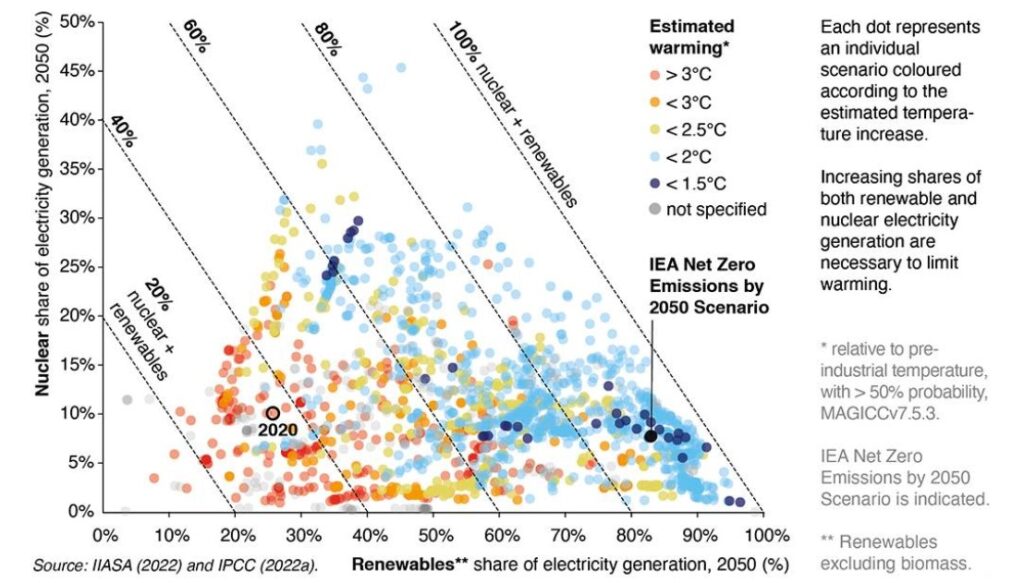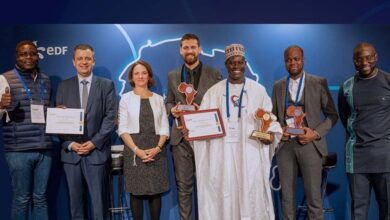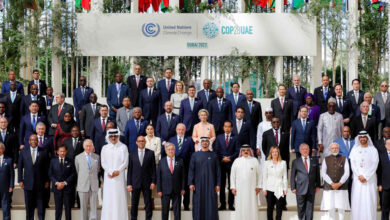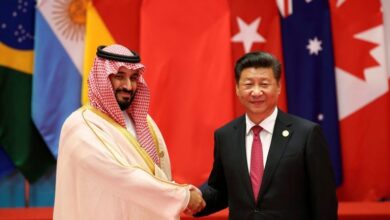AfriqueEnvironnement
Africa’s Vulnerability and the Road Ahead from COP27 to COP28

Across Africa, from the dry Sahara to the green Congo rainforests, a serious climate crisis is unfolding. This crisis knows no borders and puts at risk the balance of ecosystems, the well-being of societies, and the economies that sustain them. As we look at the aftermath of COP27 and ahead to COP28, it is crucial to understand the unique challenges Africa faces and to explore the way forward.
This article lays the groundwork for an in-depth exploration of Africa’s vulnerability to climate change, underscoring its disproportionate impact despite contributing minimally to global greenhouse gas emissions. It provides insights into the historical context of climate negotiations, particularly the disparities between developed and developing nations highlighted in COP conferences. The article also delves into urgent climate action, the state of global policies, the role of renewable energy, controversies surrounding carbon capture and storage, the significance of hydrogen in industrial decarbonization, and the contentious debate over nuclear power. The article suggests a focus on the challenges and potential solutions related to funding, technology transfer, and capacity development for adaptation efforts in economically vulnerable nations. It sets the stage for an examination of COP28 in Dubai, spotlighting discussions on a « loss and damage » fund to address the financial aftermath of climate disasters. Finally, the article examines the significant role played by the Conference of Youth (COY) and academic institutions in advancing climate action.
The Vulnerability of Africa to Climate Change
Despite contributing the least to global greenhouse gas emissions, with about 2-3% of global emissions [1], Africa bears the brunt of climate change impacts, driven by prevailing low levels of socioeconomic growth, which limit the continent’s ability to cope with the adverse effects of climate change [2, 3]. From prolonged droughts and erratic rainfall to rising sea levels and extreme weather events [4, 5], the consequences are manifold. Vulnerable ecosystems, agriculture [6], and water resources [7] face unprecedented challenges, threatening food security and livelihoods. Addressing Africa’s vulnerability is not only a matter of environmental justice but a crucial step in ensuring global climate resilience.
Historical Context of Climate Negotiations
The international community has been engaged in climate negotiations for decades, with the United Nations Framework Convention on Climate Change (UNFCCC) hosting annual conferences known as the Conference of the Parties (COP). These agreements aim to limit global temperature increases and enhance adaptation and mitigation efforts. However, the historical burden of emissions lies heavily with developed nations, while developing nations, including many in Africa, bear the brunt of the consequences [8].
COP28, hosted by the United Arab Emirates from November 30 to December 12, 2023, will be a crucial opportunity for world leaders to assess the progress made in addressing the climate crisis and negotiate climate action plans on a global scale (i.e., the “Global Stocktake” process) [9].
COP28: Charting a Course Towards 1.5°C – Evaluating Progress and Addressing Controversies
The COP28 must allow countries to take stock of the progress made since COP26, held in Glasgow in 2021. The existing global policies are expected to lead to an increase of approximately 2.7°C above pre-industrial levels. Relying solely on Nationally Determined Contributions (NDCs) would constrain the temperature rise to 2.4°C, which is well beyond the 1.5°C target set by the Paris Agreement [10].
It remains feasible to cap the temperature increase at 1.5°C and avert the most severe impacts of climate change, but only through immediate, transformative climate action. This action entails a 45% reduction in greenhouse gas emissions by 2030 compared to 2010 levels, achieving global net-zero emissions by 2050, facilitating a fair and equitable transition from fossil fuels to renewable energy sources, and escalating investments in adaptation and resilience to climate disruptions [10].
At COP26 in Glasgow, countries had agreed to gradually phase out the use of coal but never committed to completely abandoning all fossil fuels. COP28 is expected to contribute to accelerating the pace of phasing out fossil fuels, which are responsible for the majority of greenhouse gas emissions.
Renewable energy sources, such as wind, solar, and bioenergy, play a crucial role in achieving these goals. However, the transition to these technologies requires significant investments and policy support [11] to accelerate their deployment. According to the United Nations, a minimum of $4 trillion annually must be invested in renewable energy, encompassing both technology and infrastructure, by 2030 in order to achieve net-zero emissions by 2050 [12].
Offshore floating photovoltaic [13], solar water desalination [14], and agrivoltaic [15] systems represent innovative and emerging forms of renewable energy that play a pivotal role in addressing the interconnected challenges of energy, food, and water within the nexus.
While carbon capture and storage (CCS) has been promoted as a solution to decarbonize carbon-intensive industries, it remains a controversial topic, with some organizations calling for the rejection of CCS and other speculative and unproven technologies, including carbon capture utilization and storage (CCUS) and carbon removal by direct air capture (CDR) [16].
Hydrogen is expected to play a significant role in decarbonizing different hard-to-abate industrial sectors, such as steel and cement production, as well as in long-haul vehicles, maritime transport, and aviation. However, the lack of widespread hydrogen production facilities and hydrogen fueling stations is a key barrier that needs to be overcome to support the transition to hydrogen [17].
Expanding the proportions of both renewable and nuclear power generation is essential to restrict the extent of global warming (Figure 1). However, nuclear remains a controversial topic, with opponents arguing that it poses significant risks, including the potential for nuclear accidents and the long-term storage of nuclear waste.

A Spotlight on Adaptation and Climate Finance
Countries with the lowest economic resources are particularly vulnerable to the adverse impacts of climate change (Figure 2). These nations face heightened risks, and it is imperative for the international community to provide financial support, facilitate technology transfer, and implement capacity development programs to support their efforts in adapting to the challenges posed by climate change. Notably, entities such as the Green Climate Fund offer financial support to developing countries, aiding them in both mitigating and adapting to the impacts of climate change.

According to the United Nations, developing countries will need at least $200 billion per year by 2030 to adapt to the increasingly severe effects of climate change. They will also require funds to replace polluting energy sources with clean ones. In addition, there is the cost of damages already caused by climate disasters. In Dubai, countries will be tasked with establishing a « loss and damage » fund to address this situation. This fund is expected to unlock at least $100 billion by 2030, according to developing countries. Vulnerable nations are seeking more funds for their transition, and they insist that rich countries, whose past CO2 emissions largely contribute to climate change, should bear the responsibility. Rich countries must demonstrate that they have fulfilled their commitment to provide $100 billion annually for developing countries to take climate action [9].
The Vital Role of COY and Academia in Shaping Climate Action
The Conference of Youth (COY), initiated by YOUNGO, plays a key role in engaging youth in climate discussions and bringing fresh perspectives. Universities and think tanks contribute significantly through research and partnerships, acting as knowledge hubs that fuel innovation and influence policy. COY28, an annual event, provides crucial capacity-building for active participation in the UN Climate Change Conference. Collaborative efforts across sectors, including academia, are essential for evidence-based solutions to address climate challenges and ensure the active involvement of youth in shaping a sustainable future.
Conclusion
As the world prepares for COP28, the spotlight on Africa’s vulnerability to climate change remains crucial. The negotiations must yield concrete actions, reflecting a shared commitment to safeguarding the future of the continent and the planet. Mitigation efforts, adaptation strategies, equitable climate finance, engaging young individuals, and fostering innovation are integral components of a collective response that transcends borders and ensures a sustainable and resilient future for all.
References
[1] United Nations Environment Programme (UNEP), Responding to Climate Change, https://www.unep.org/regions/africa/regional-initiatives/responding-climate-change
[2] Bouramdane, A.-A. Assessment of CMIP6 Multi-Model Projections Worldwide: Which Regions Are Getting Warmer and Are Going through a Drought in Africa and Morocco? What Changes from CMIP5 to CMIP6? Sustainability 2023, 15, 690. https://doi.org/10.3390/su15010690
[3] Bouramdane, A.-A.: Determining Vulnerable Areas to Warming and Drought in Africa and Morocco Based on CMIP6 Projections: Towards the Implementation of Mitigation and Adaptation Measures, EGU General Assembly 2023, Vienna, Austria, 24–28 Apr 2023, EGU23-2456, https://doi.org/10.5194/egusphere-egu23-2456, 2023.
[4] Bouramdane, A.-A., « Climate Risks and Energy Transition in Morocco: Vulnerability to Climate Losses and Damages and Uncertainty in the Renewable Electricity Mix Under Different Penetration », Lambert Academic Publishing (LAP), 2023, ISBN: 978-620-6-17980-1, https://www.morebooks.shop/shop-ui/shop/product/9786206179801
[5] Bouramdane, A.-A., « Chaleur Caniculaire, Incendies Gigantesques à Répétition: Des Signes du Changement Climatique? », énergie/mines & carrières, 2022, DOI: 10.5281/zenodo.7594264. URL: https://energiemines.ma/chaleur-caniculaire-incendies-gigantesques-a-repetition-des-signes-du-changement-climatique/
[6] Bouramdane, A.-A., « Quelle Relation entre Agriculture et Changement Climatique? », énergie/mines & carrières, 2023, DOI: 10.5281/zenodo.7730008. URL: https://energiemines.ma/quelle-relation-entre-agriculture-et-changement-climatique/
[7] Bouramdane, A.-A., « Solutions Pour Réduire la Pression sur l’Eau », énergie/mines & carrières, 2023, DOI: 10.5281/zenodo.8021765. URL: https://energiemines.ma/solutions-pour-rerduire-pression-eau/
[8] Bouramdane, A.-A., « Climate Resilience: Insights from Global Negotiations and Morocco’s Path to Sustainability », Lambert Academic Publishing (LAP), 2023, ISBN: 978-620-6-75083-3, https://www.morebooks.shop/shop-ui/shop/product/9786206750833
[9] France 24, Énergies fossiles, pertes et dommages… Quels sont les enjeux de la COP28 à Dubaï?, 2023, https://www.france24.com/fr/plan%C3%A8te/20231127-%C3%A9nergies-fossiles-pertes-et-dommages-quels-sont-les-enjeux-de-la-cop28-%C3%A0-duba%C3%AF
[10] CAT (Climate Action Tracker). https://climateactiontracker.org.
[11] UNCTAD, Investing in the Energy Transition: Countries Need More Balanced Policies, https://unctad.org/news/investing-energy-transition-countries-need-more-balanced-policies
[12] United Nations, Five Ways To Jump-Start The Renewable Energy Transition Now, https://www.un.org/en/climatechange/raising-ambition/renewable-energy-transition
[13] Bouramdane, A.-A., « Préservation des Ressources d’Eau et Transition Énergétique: Point sur le Photovoltaïque Flottant », énergie/mines & carrières, 2023, DOI: 10.5281/zenodo.8021774. URL: https://energiemines.ma/preservation-des-ressources-deau-et-transition-energetique-point-sur-le-photovoltaique-flottant/
[14] Bouramdane, A.-A., « Un Avenir Hydrogéné au Maroc : Dessalement de l’Eau – Défis et Promesses », énergie/mines & carrières, 2023, URL: https://energiemines.ma/un-avenir-hydrogene-au-maroc-dessalement-de-leau-defis-et-promesses/
[15] Bouramdane, A.-A., « Agrivoltaïque, De Quoi Parle-t-on Au Juste? », énergie/mines & carrières, 2022, DOI: 10.5281/zenodo.7594342. URL: https://energiemines.ma/agrivoltaique-de-quoi-parle-t-on-au-juste/
[16] CNBC, Carbon Capture is Expected to Play a Pivotal Role in the Race to Net Zero Emissions. But Not Everyone Agrees, 2021, https://www.cnbc.com/2021/07/20/climate-crisis-and-carbon-capture-why-some-are-worried-about-its-role.html
[17] Constantin, A. (2023). Nuclear Hydrogen Projects to Support Clean Energy Transition: Updates on International Initiatives and IAEA Activities. International Journal of Hydrogen Energy.
By Ayat-Allah Bouramdane (PhD)
Researcher at the Laboratory of Renewable Energies and Advanced Materials (LERMA) and Assistant Professor at the College of Engineering and Architecture, International University of Rabat (IUR).






